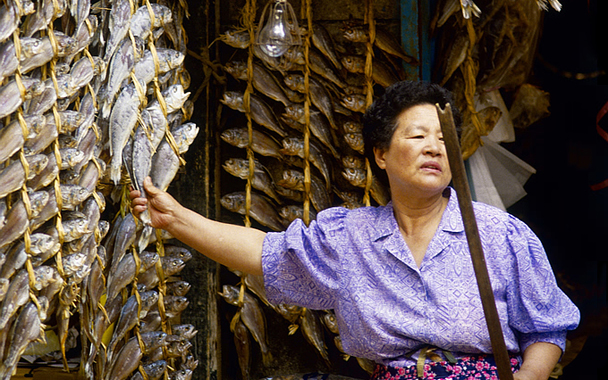T
sukiji in Tokyo and New York’s late Fulton Fish Market may have more of a hold on the popular imagination, but the Noryangjin Marine Products Market is one of the greatest food spectacles on earth. A yawning structure in central Seoul, as large as several football stadiums laid end to end, it’s crammed snout-to-elbow with exotic sea creatures from every conceivable aquatic locale: acres of stingrays aligned precisely as roof tiles; gilt lengths of ribbonfish; regiments of pike; oceans of halibut; endless trays of pickled clams; and more kinds of jacks and mackerels and anchovies than could be identified with a libraryful of reference books. As you weave through the 700-odd stalls, dodging the blasts of frigid water that the merchants occasionally sluice through the aisles, and the very small men charging through bearing very large bags of ice, you may notice the absence of anything resembling a fishy reek, replaced instead by the fresh smell of the sea.
Koreans favor species toward the bottom rungs of the food chain, so while you will see the occasional bluefin or salmon at Noryangjin, they are far outnumbered by croaker and corvina, bubbling clams and giant octopus whose arms extend farther than Shaquille O’Neal’s. You will also pass miles of live-seafood tanks, many of them filled with the usual lobsters, prawns, and crabs, but also finfish of every description, and a disconcerting array of bottom-of-the-sea stuff whose uses are difficult to contemplate. (It’s hard to know which sea squirts are more alarming—the ones that look a little like warty, pulsing pineapples, or the pink ones resembling throbbing uncircumcised phalluses, right down to the undulating slit at the business end.)
There is a big auction area on the second floor of the 24-hour market, but almost all of the downstairs stalls are prepared to slice any one of their fish into sashimi for you on the spot—or better yet, to put your purchases into plastic bags and point you toward one of the cavelike seafood restaurants that line the north end of the complex, where they will serve up your sashimi in the traditional Korean style with sesame leaves, bean paste, sliced chiles, and raw garlic, and transform the rest of the creature into a seething cauldron of spicy, bright-red fish soup. Throw in some steamed Korean blue crabs, a few grilled prawns, some kimchi, and a bottle or two of soju, and you’ve got the greatest Korean breakfast in the world.
The stalls are unnumbered and unnamed, but I like the crab stall toward the extreme northwest corner of the market run by Robert, who spent much of his life in Wichita, Kansas—you will spot the phone number 813-9780 above his stall.




 Pinterest
Pinterest


